Teniente Rey is a street in Old Havana that extends from the steps of the Cuban capitol building about three-quarters of a mile eastward toward the waterfront. (The street is also marked with signs as Calle Brasil for a few blocks near the capitol building.)
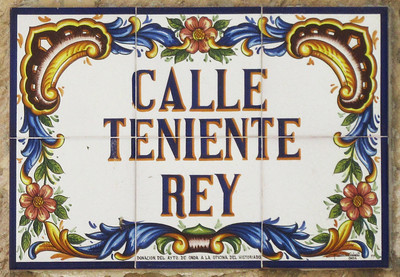
The capitol building will be a stopping point for most tours of the old city. It makes for an attractive photo from many angles, day and night.

Since Old Havana is a compact area, we passed the building several times during our stay. One morning, we saw what appeared to be a diplomatic arrival at the building with a ceremonial honor guard on duty to greet the visitor.

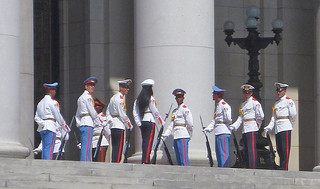
On our first visit to the area, we joined the tourists using the building for a background in this photo.

Walking away from the capitol toward the waterfront, we encountered an eclectic mix of bars and restaurants as we passed Plaza del Cristo and the edge of Plaza Vieja (our favorite of the area's restored squares) before arriving at the church buildings that line the approach to Plaza de San Francisco de Asis.
D'Next, a diner style restaurant, has excellent hamburgers and some interesting appetizer plates. It is reported to have great breakfasts as well as lunch.

Teniente Rey 360 served up an excellent dinner for two including deserts for about $25.

We had numerous good meals at the restaurants on this street over the course of our stay. We had lunch at Saoco twice and an excellent dinner at Restaurant Bulgaria. It serves Cuban food, despite the name.


Day or night, our meals were accompanied by live and lively music. Stopping for a drink along the avenue presented the opportunity to glance back at the capitol dome as the sun set. At times, the blend of competing bands outside was a bit harsh, as each seemed to represent a distinct style.
This is one of the most popular tourist streets in Old Havana and has restricted vehicle traffic in areas.

Local residents shop for fresh vegetables from vendors who set up carts along the avenue.


Just before reaching Plaza Vieja, there is even a gelato store serving a variety of traditional as well as tropical flavored ice creams.

Near the foot of Teniente Rey, we encountered an entrance to Zanja Real, the Havana Aqueduct constructed between 1565 and 1592 with a story of its importance to the development of agriculture and manufacturing in Cuba. (* see translation at the end of this page)


Calle Teniente Rey comes to an end at Calle Oficios, once a busy home to notaries, blacksmiths, foundries, silversmiths, caulkers and carpenters, mostly related to port activity. (** see translation at the end of this page)


Turning onto Calle Oficios, we quickly came into the heart of Plaza de San Francisco, but not before passing this curious bronze statue of "The Gentleman from Paris."
This homeless gentleman was a much beloved figure in Havana in the mid twentieth century. Restoration of the square in 2001 included the erection of a statue to his memory; parts of the statue have been polished to a shine as visitors stroke his beard and index finger for good luck. (*** See full explanation below.)
TRANSLATION OF SIGNS:
These are presented via Google Translate and may not be quite perfect!
* Zanja Real:
Zanja Real
Built between the years 1565 to 1592
The Havana aqueduct, known as Zanja Real, was the first to be built in Cuba, promoted in 1545 by Juan de Rojas, the richest neighbor of the town, and the patronage of Governor Juanes Dávila.
After various technical and economic mishaps, the works began in 1566, under the direction of the master master Francisco de Calona, but the unstable nature of the ground on which the Ditch was founded and the unpredictable hurricanes meant that the waters derived from the Almendares River did not reach the Plaza de San Francisco until 1591, and the Callejón de El Chorro in the following year.
The execution of the Ditch reveals a careful leveling study in its layout, since the waters were conducted by gravity through a path of about 11 km, being distributed upon reaching the city by a network of canals that distributed it to public fountains, and to other branches for the supply to religious institutions, the Crown and private properties. In the 17th and 18th centuries, due to public needs, new pipes were added that crossed different points of intramural Havana.
This aqueduct also provided other services such as irrigation ditches: driving force for the agricultural transformation industries, mainly in sugar mills and roller mills to make powdered tobacco. Its waters had an important application in the 18th century to move the great saw that cut the hard Cuban wood used in the construction of the ships of the Havana Arsenal.
In the 18th century and especially in the 19th century, the Zanja Real was insufficient to supply a cosmopolitan city enriched by the sugar trade. This forced the creation of two new aqueducts, that of Fernando VII. built between 1831 and 1835, and later the Canal de Venta, built between 1859 and 1897, finally named de Albear in honor of its designer and builder, the eminent engineer Francisco de Albear y Lara. This last work is considered a marvel of 19th century engineering and is still in use.
** Calle Oficios:
Calle Oficios
between Teniente Rey and bitterness
Along Calle Oficio the primitive town extended from the Plaza de Armas to the south, close to the bay. It was also one of the first to specialize in establishments, whose artisans gave it its name: notaries, blacksmiths, foundries, silversmiths, caulkers, carpenters, mostly related to port activity.
There were also small goldsmith workshops, especially in sacred jewelry, who achieved great fame for their works. It is the main communication route between the Plaza de Armas, the Plaza de Sa Francisco and the Alamed de Paula, all first class public spaces in the city, which is why it has been classified as an axis of urban interconnection.
This is a privileged segment within the street as it forms part of the square and has diverse architectural styles: domestic, religious, civil-public. Its rehabilitation allowed opening a range of suggestions for the sake of economic, tourist and cultural development.
*** The Gentleman from Paris - From www.atlasobscura.com
El Caballero de Paris (The Gentleman from Paris)
Havana, Cuba
This statue in Plaza San Francisco commemorates a beloved figure from 1950s Havana.
He roamed the streets of Havana in bizarre clothing but could quote classic Spanish literature. Today his bones rest in an unlikely place. El Caballero de Paris (the Gentleman from Paris) was a familiar sight in the mid-20th century of Havana.
He was a thin man with wavy blond hair and a long beard who dressed in elaborate costumes reminiscent of the elegant European upper classes; a black cloak over a black suit with a flower in the jacket’s lapel. Because of his appearance, Havana residents christened him the Gentleman from Paris. Although he slept in the streets of Havana and depended on the largess of kindhearted Havana residents for his daily meals, he could recite passages from classic Spanish literature unerringly and with dramatic flair. Jose Maria Lopez Lledín, A.K.A. el Caballero de Paris, was born in Lugo, a major city in Spain’s northwestern autonomous region of Galicia. The Spaniard was rumored to have emigrated to Cuba as a young boy of 14. He labored at odd jobs in restaurants and hotels doing work typically done by the Spanish immigrants that poured into Cuba at that time.
Years later he was unjustly convicted of a crime and sent to prison, an experience that caused him to retreat to a fantasy world from which he would never return. Once out of prison, he wandered the city giving little drawings to the occasional passersby. Over the years he became a beloved figure within Havana.
Although never violent, he became increasingly irrational until a compassionate doctor admitted him into Havana’s local psychiatric asylum. Eight years later he died there, still quoting classic Spanish poetry and literature.In 2001, the city of Havana began its restoration of the colonial sector of Old Havana. The city’s official historian had the Spaniard’s bones exhumed and buried with much fanfare in the church of San Francisco in the beautiful plaza of the same name. This was one of the Parisian Gentleman’s favorite places to roam.
But the citizens of Havana were still not ready to let the Parisian Gentleman go. This symbol of Havana lives on in a bronze statue of him placed at the door of San Francisco church in Old Havana. Parts of the statue have been polished to a shine as visitors stroke his beard and index finger for good luck.

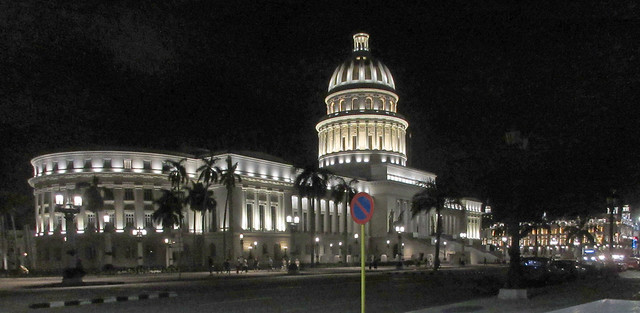
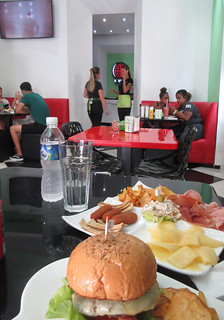


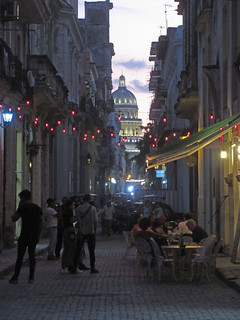
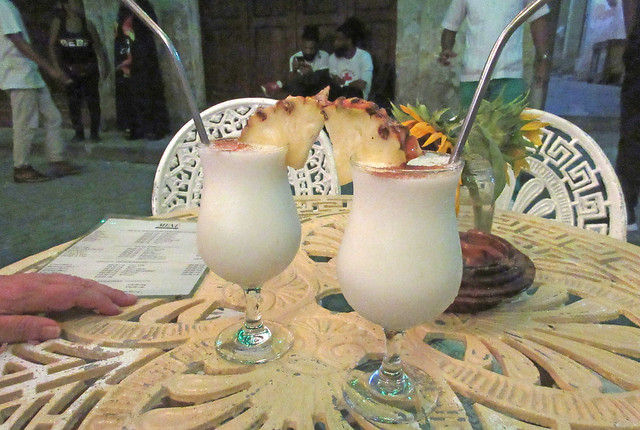
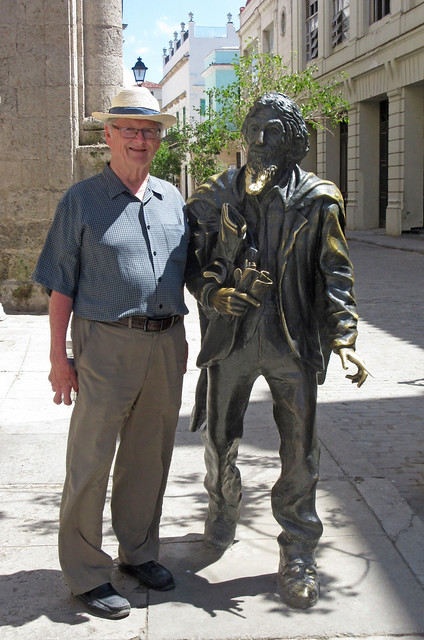





No comments:
Post a Comment